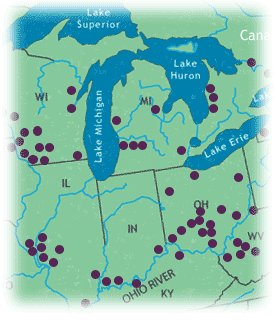 The Hopewell Indians were not the first indigenous people to live in what is now called Michigan. People were living here from about 14,000 B.C.E. They were not the first to trade with others. Archaeologists have artifacts and evidence of trade between earlier indigenous people in Michigan. We do not even know what the indigenous people who lived in the eastern part of North America called themselves at the time the Hopewell lived. So why have we chosen the Hopewell to study?
The Hopewell Indians were not the first indigenous people to live in what is now called Michigan. People were living here from about 14,000 B.C.E. They were not the first to trade with others. Archaeologists have artifacts and evidence of trade between earlier indigenous people in Michigan. We do not even know what the indigenous people who lived in the eastern part of North America called themselves at the time the Hopewell lived. So why have we chosen the Hopewell to study?
During the period of time that archaeologists have named the Middle Woodland era , some people in Michigan began to follow the ideas of the Hopewell culture. These ideas came mainly from people living in Illinois at this time, but the Michigan Hopewell also had contact with Hopewell ideas from Ohio.
|
Prehistoric Eras in Michigan
|
| Paleo-Indian |
12,000 B.C.E. to 8,000 B.C.E.
|
| Early Archaic |
8,000 B.C.E. to 6,000 B.C.E.
|
| Middle Archaic |
6,000 B.C.E. to 3,000 B.C.E.
|
| Late Archaic |
3,000 B.C.E. to 1,000 B.C.E.
|
| Early Woodland |
1,000 B.C.E. to 300 C.E.
|
| Middle Woodland |
300 C.E. to 500 C.E.
|
| Late Woodland |
500 C.E. to 1620 C.E.
|
So why the Hopewell? By using the Hopewell, indigenous groups of the Middle Woodlands era, we can track the continuum of development of indigenous people from the paleo-Indian era through to Middle Woodland era. A part of the story of human development and adaptation that is relevant to prehistoric Michigan history. The artifacts of the Michigan Hopewell demonstrate how the knowledge and culture of the earlier indigenous people in Michigan were passed on, modified, and improved upon and finally used by the Hopewell 11,700 years later.
 We have a rich set of artifacts left by the Hopewell. Knowledge of Hopewell communities throughout eastern North America provides a rich insight into how the people who engaged in this type of mound building lived. This knowledge explains not only the mound under investigation, but helps to explain the traditions of the Hopewell mound builders in other places.
We have a rich set of artifacts left by the Hopewell. Knowledge of Hopewell communities throughout eastern North America provides a rich insight into how the people who engaged in this type of mound building lived. This knowledge explains not only the mound under investigation, but helps to explain the traditions of the Hopewell mound builders in other places.
Many archaeologists believe that the evidence found in the Hopewell mounds in Michigan which date to the Middle Woodlands era is an indication of how advanced the indigenous cultures of Michigan had become. Michigan Middle Woodlands and Late Woodlands people were well placed to advance to the level of complexity and refinement we associate with many indigenous cultures of South America.
As teachers of history we have the responsibility of teaching four history standards. Teaching the Hopewell will provide opportunities for students to recognize how cultures of the past influenced cultures that followed. Understanding the lives of people from prehistoric eras requires not only reading about indigenous cultures, but also requires the skills of archaeology to create plausible and defendable hypotheses.
Learning to compose a narrative based on evidence is a critical skill of the historian. The Hopewell example provides many artifacts but no written narrative. It is up to the student to create narratives, giving students the rare opportunity to write history. And finally, the Hopewell culture the flowering of the prehistoric indigenous people of Michigan was arrested in its further development by contact with European cultures. There is no way of knowing what these indigenous groups could have created or would have become had this contact not been made.
return to top